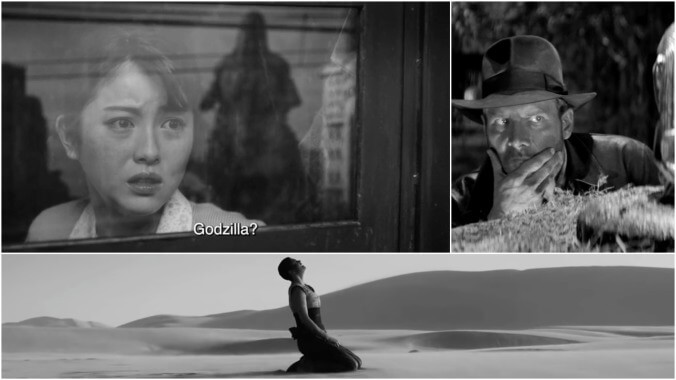Godzilla Minus One/Minus Color and the rise of the de-colorized version
For the last two decades, filmmakers have been stripping their films of color. But is it really anything more than a novelty?

Godzilla Minus One returns to theaters this weekend minus one important element: Color. Godzilla Minus One/Minus Color, a black-and-white version of the king lizard’s biggest Japanese movie ever, makes this old-fashioned blockbuster feel more like the era it mimics. For one week, the monster stomps into multiplexes with an Oscar nomination and the gravitas that comes with a black-and-white cut. It isn’t alone.
Godzilla is the latest significant sci-fi star stripped of his color, a trend that’s been going on since the late mid-2000s. In 2008, Frank Darabont included a black-and-white version of The Mist for the film’s DVD release. In the video introduction to the re-release, Darabont says his monochrome Mist was his original intention because “there’s something about Stephen King’s story that’s a bit of a throwback.” King, Darabont continues, was inspired by those old grainy black-and-white movies, something the director hoped to reflect. Another Darabont project, season one of The Walking Dead, aired in black-and-white on AMC in 2016, emulating the original look of the comics and zombie classics like Night Of The Living Dead.
Advancements in digital filmmaking throughout the 2000s and 2010s helped make these stylist desaturatizations a viable option, allowing directors who imagined their films devoid of color to indulge their fantasies. George Miller called 2017’s Mad Max: Fury Road – Black & Chrome “the best version of this movie.” That year, James Mangold removed the color from Logan for Logan Noir, putting a little more prestige on his elevated superhero movie. By 2021, HBO Max was releasing two versions of the Snyder Cut: Zack Snyder’s Justice League and Zack Snyder’s Justice League: Justice Is Gray. Even Guillermo del Toro’s Best Picture nominee Nightmare Alley got a black-and-white redux, Vision In Darkness And Light, making its resemblance to the 1946 original more pronounced.
Unsurprisingly, other countries were way ahead of Hollywood on this—even in terms of giving the new cuts silly titles. In 2006, the DVD release of Park Chan-Wook’s Lady Vengeance included the “Fade To Black And White Version,” which Park preferred to the original. That one makes even more impressive use of the form, with the color photography slowly fading to black-and-white throughout the movie. Park’s compatriot, Bong Joon-Ho, also jumped on the trend. His 2009 thriller Mother received a 2013 black-and-white re-release, as did Parasite, which went color-less for its 2020 Criterion release. Bong cheekily said that it would help make his film a classic.
“I think it may be vanity on my part, but when I think of the classics, they’re all in black and white,” Bong said at the International Film Festival Rotterdam. “So I had this idea that if I turned my films into black and white, then they’d become classics.”
Black-and-white has never been easier to accomplish nor more in vogue—aside from, you know, when it was the norm. Half of the nominees for Best Picture feature scenes in black-and-white, and all five of the cinematography nominees do—El Conde being the only nominee to go all in. There’s some added prestige, a level of import placed on the twin-tone aesthetic that blockbusters wish to glean. As George Miller said, it’s usually reserved for art films.
Godzilla Minus One has already garnered glowing reviews, but the black-and-white makeover makes it more nostalgic than artful. Shots of Godzilla crushing Tokyo under its massive feet with the horns of the classic Godzilla theme blaring over the soundtrack look about as close as a modern movie could come to the 1954 original. Just as the late Peter Bogdanovich attempted to make a closer connection between The Last Picture Show and its sequel, Texasville, by releasing the latter’s director’s cut in black-and-white, this stylistic choice links the past with something new. Godzilla Minus One was already an old-fashioned film. Minus Color attempts to make it look old-fashioned too.
All this is certainly a worthy exercise. When something is removed from a piece of art, we’re forced to consider what it added in the first place. Steven Soderbergh took the color and sound out of Raiders Of the Lost Ark to understand Steven Spielberg’s cinematic language. He writes on his Extension 765 blog:
So I want you to watch this movie and think only about staging, how the shots are built and laid out, what the rules of movement are, what the cutting patterns are. See if you can reproduce the thought process that resulted in these choices by asking yourself: why was each shot—whether short or long—held for that exact length of time and placed in that order? Sounds like fun, right? It actually is.
But this is, for lack of a better term, all a novelty at worst and an experiment at best. These movies will likely never be the definitive or most widely seen versions, despite how many filmmakers say it was always their intention. After all, NBC doesn’t air the colorized It’s A Wonderful Life.
Still, it makes a good case for the continued interest in black-and-white, a style still of interest to audiences. Why else would YouTube channels devote time to series like “Better In Black And White,” or viewers opt to desaturate movies on their own? Either way, it allows viewers to see these movies with fresh eyes and added resonance. It might be a novelty, but the latest version of Godzilla Minus One proves one thing: Godzilla destroying Tokyo always looks best minus color.